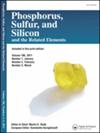Effect of bismuth oxide on the gamma-ray shielding properties of phosphate glass P2O5-Bi2O3-Na2SO4-ZnO in the energy range (0.1–3 MeV)
IF 1.4
4区 化学
Q4 CHEMISTRY, INORGANIC & NUCLEAR
Phosphorus, Sulfur, and Silicon and the Related Elements
Pub Date : 2025-01-02
DOI:10.1080/10426507.2025.2452579
引用次数: 0
Abstract
In this paper, the gamma radiation attenuation parameters were calculated using Phy-X/PSD for a prepared quaternary system of phosphate glass (95-x)P2O5-xBi2O3-3Na2SO4-2ZnO, where (x = 30, 40, and 50 mol%). In addition, the attenuation interactions were calculated using the X-Com program, as all these calculations were done in the range of energies (0.1–3 MeV). The results showed that the S3 sample had the highest value of the mass attenuation coefficient up to the energy value of 0.8261 MeV, after which the values of the three investigated samples were approximately equal. The S3 sample also has the lowest value for a half value layer during the measured range of energy. The results also showed that the photoelectric effect interaction is the largest contributor to the attenuation process at the first three energies (0.1, 0.15, and 0.2 MeV), and at energy values with 0.3–3 MeV, the Compton effect becomes the largest contributor to the attenuation process. The contribution of the pair production effect interaction begins to appear at the energy 1.025 MeV, and its contribution to the gamma ray attenuation process increases gradually in association with the Compton effect interaction until the value of 3 MeV.
氧化铋对P2O5-Bi2O3-Na2SO4-ZnO磷酸盐玻璃(0.1-3 MeV) γ射线屏蔽性能的影响
本文利用Phy-X/PSD计算了制备的磷酸玻璃(95-x)P2O5-xBi2O3-3Na2SO4-2ZnO四元体系的γ辐射衰减参数,其中(x = 30,40和50 mol%)。此外,使用X-Com程序计算衰减相互作用,因为所有这些计算都是在能量范围(0.1-3 MeV)内进行的。结果表明,S3样品的质量衰减系数最高,能量值为0.8261 MeV,之后3种样品的质量衰减系数基本相等。在测量的能量范围内,S3样品也具有半值层的最低值。在前三个能量(0.1、0.15和0.2 MeV)处,光电效应相互作用对衰减过程的贡献最大,在0.3-3 MeV处,康普顿效应对衰减过程的贡献最大。对产生效应相互作用的贡献在1.025 MeV能量处开始出现,其对伽马射线衰减过程的贡献随着康普顿效应相互作用的增加而逐渐增加,直到3 MeV。
本文章由计算机程序翻译,如有差异,请以英文原文为准。
求助全文
约1分钟内获得全文
求助全文
来源期刊
CiteScore
2.60
自引率
7.70%
发文量
103
审稿时长
2.1 months
期刊介绍:
Phosphorus, Sulfur, and Silicon and the Related Elements is a monthly publication intended to disseminate current trends and novel methods to those working in the broad and interdisciplinary field of heteroatom chemistry.

 求助内容:
求助内容: 应助结果提醒方式:
应助结果提醒方式:


